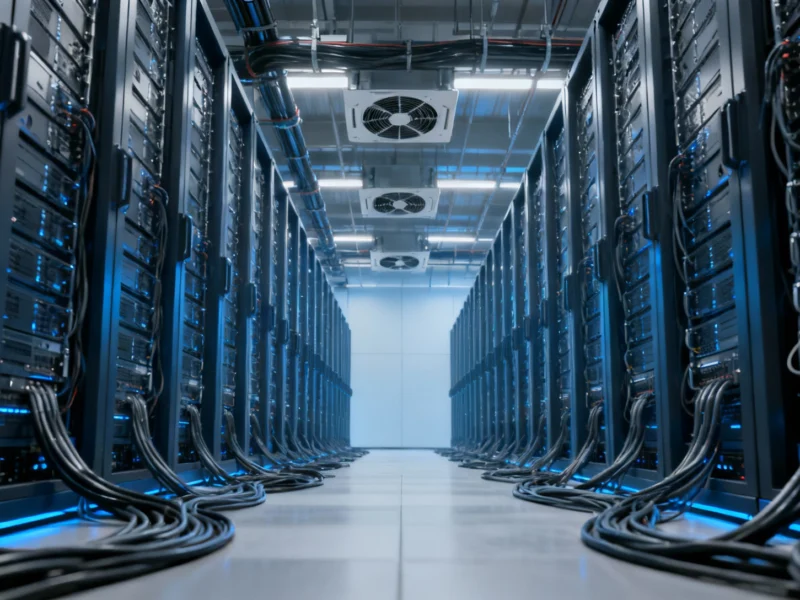The Unprecedented Energy Appetite of Modern AI Infrastructure
The artificial intelligence revolution is encountering a formidable obstacle: power consumption. As detailed in recent analysis of NVIDIA’s escalating power requirements, the company’s AI server platforms have witnessed a staggering 100-fold increase in energy consumption between the Ampere and Kyber generations. This exponential growth trajectory raises critical questions about whether global energy infrastructure can sustain AI’s relentless expansion.
Industry analysts, including Ray Wang, have documented how NVIDIA’s aggressive product evolution directly correlates with skyrocketing power demands. What began as manageable energy footprints have transformed into industrial-scale power consumption that challenges conventional data center design principles. The transition from Hopper’s 10 KW per chassis to Blackwell’s nearly 120 KW rating demonstrates how rapidly the landscape is shifting, particularly as semiconductor manufacturing advances enable increasingly powerful processors.
Anatomy of the Power Surge: Technical Drivers Behind Energy Demands
Multiple factors converge to create this energy consumption phenomenon. The primary driver remains the increasing GPU density per rack, with each generation featuring higher Thermal Design Power (TDP) ratings. NVIDIA’s Blackwell architecture exemplifies this trend, packing more computational power into each unit while dramatically increasing energy requirements.
Advanced interconnection technologies contribute significantly to the power equation. The implementation of sophisticated NVLink and NVSwitch fabrics enables unprecedented computational density but demands substantial energy investments. These interconnects allow for seamless communication between GPUs but introduce additional power layers that compound overall consumption. Meanwhile, global data center expansion continues at a breakneck pace to accommodate growing computational needs.
The Hyperscale Arms Race: When GW Becomes the Standard Metric
Major technology corporations have transformed AI infrastructure development into a high-stakes competition measured in gigawatts. OpenAI, Meta, and other industry leaders now conceptualize their computational ambitions in terms previously reserved for national energy grids. The pursuit of artificial general intelligence (AGI) has catalyzed an infrastructure boom where individual campuses aim to deploy over 10 GW of computing capacity within coming years.
To contextualize these figures, consider that 1 GW of AI-related energy consumption could power approximately one million American homes—excluding the substantial additional requirements for cooling systems and power delivery infrastructure. This scale means single AI facilities now consume electricity comparable to mid-sized countries or multiple large U.S. states, creating unprecedented pressure on regional power grids and prompting regulatory responses across global markets.
Global Energy Implications and Economic Consequences
The International Energy Agency’s 2025 “Energy & AI” research presents alarming projections: AI alone may cause electricity consumption to double by 2030, growing at nearly four times the rate of overall grid expansion. This disproportionate growth threatens to outpace energy production capabilities and could lead to increased electricity costs for households, particularly in regions hosting major AI data center clusters.
The situation has attracted political attention, with the Trump administration repeatedly highlighting energy infrastructure concerns. As nations compete in the global AI race, the energy dimension introduces both strategic vulnerabilities and opportunities for innovation. The challenge extends beyond mere power generation to encompass transmission, distribution, and thermal management, with implications for critical infrastructure security and operational resilience across sectors.
Industry Responses and Future Trajectories
Technology firms are pursuing multiple strategies to address these energy challenges. Efficiency improvements at both hardware and software levels offer some mitigation, while investments in renewable energy sources and advanced cooling technologies provide partial solutions. However, the fundamental tension between computational ambition and energy reality persists.
The industry faces a critical juncture where continued exponential growth in AI capabilities must be reconciled with practical energy constraints. This balancing act requires coordinated effort across technology developers, energy providers, and policymakers. As the sector evolves, the relationship between computational progress and power consumption will determine whether current growth trajectories can be sustained, particularly as parallel technological sectors also experience rapid expansion.
The coming years will test whether innovation can outpace consumption, or whether the AI revolution will face energy-imposed limitations. What remains certain is that the relationship between artificial intelligence and energy infrastructure will define technological progress for the foreseeable future.
Based on reporting by {‘uri’: ‘wccftech.com’, ‘dataType’: ‘news’, ‘title’: ‘Wccftech’, ‘description’: ‘We bring you the latest from hardware, mobile technology and gaming industries in news, reviews, guides and more.’, ‘location’: {‘type’: ‘country’, ‘geoNamesId’: ‘6252001’, ‘label’: {‘eng’: ‘United States’}, ‘population’: 310232863, ‘lat’: 39.76, ‘long’: -98.5, ‘area’: 9629091, ‘continent’: ‘Noth America’}, ‘locationValidated’: False, ‘ranking’: {‘importanceRank’: 211894, ‘alexaGlobalRank’: 5765, ‘alexaCountryRank’: 3681}}. This article aggregates information from publicly available sources. All trademarks and copyrights belong to their respective owners.



